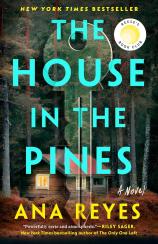Reading Group Guide
Discussion Questions
The House in the Pines

1. Maya shies away from true intimacy by withholding important information from Dan. How does finally telling the truth about her alcohol dependence and Klonopin withdrawal, as well as Aubrey’s death and her suspicions about Frank, change Maya’s relationship with Dan?
2. Maya’s experience with addiction ranges from always liking “a good buzz, ever since the first time [Aubrey] swiped a pint of her mom’s vodka and they drank it stirred into Sunny D” to rationalizing “her dependence in so many ways, telling herself it wasn’t a lie, just an omission; that she kept the pills in an aspirin bottle for convenience, not to hide them.” How does Maya’s dependence on various substances serve to keep her isolated in her adult life?
3. Dr. Barry, Maya’s one-time therapist, says, “The unwell mind is rarely capable of recognizing its own illness”; he also tells her the mind will try to explain what it does not understand by creating patterns. Is Maya a reliable narrator, even to herself? How much does she trust what she perceives and remembers, and how much does she doubt her own intuition? Did you have faith in her perceptions?
4. Technology and social media play an important role in Maya’s attempts to learn the truth about Frank. Do you think events would have played out differently if younger Maya had been able to research Frank online? Or would his sway still be as strong, regardless of all the information available?
5. The author emphasizes the importance of sharing stories. When Maya meets Dan, she feels the “intimacy of being with someone who loved the same stories.” Maya and Aubrey connect in English class while doing a project on Emily Dickinson. Brenda tells the story of meeting Jairo repeatedly, until it takes on a fable-like quality. But Maya also realizes she “might as well have handed Frank a key to her head and her heart the day she told him the story of her dead father.” How do stories allow these characters to open up to one another? Is this sharing of self through stories always for the best, or can it have more sinister consequences?
6. How is Frank able to read Maya and prey on her vulnerability? What patterns can Maya discern in her experiences with Frank?
7. Maya is described as “half Guatemalan, a quarter Irish, and a quarter Italian”; she “looked Hispanic but had grown up with a single white mom and knew very little about her family in Guatemala.” By the end of the novel, how does Maya begin to integrate her Guatemalan roots, connect with her father, and understand this part of her history?
8. Inherited trauma is woven throughout Maya’s story: her father’s violent death and Guatemala’s tumultuous history, her aunt Lisa’s mental illness, even the PCBs that poisoned the Housatonic River and Silver Lake. How does the author plant seeds of hope that it’s possible to move beyond the damage of the past?
9. The author writes current scenes in the past tense, whereas past sections are in the present tense. In what ways was Maya more engaged in the past? How has Aubrey’s death and her time with Frank affected her?
10. Were you surprised when you learned the truth about Frank’s cabin? If not, when did you begin to suspect that something about it was wrong?
11. What did you think of the balance between the past and present sections in the novel? Did the two intersect differently for you as the read went on? Why or why not?
The House in the Pines
- Publication Date: December 5, 2023
- Genres: Fiction, Psychological Suspense, Psychological Thriller, Suspense, Thriller
- Paperback: 336 pages
- Publisher: Dutton
- ISBN-10: 0593186737
- ISBN-13: 9780593186732







